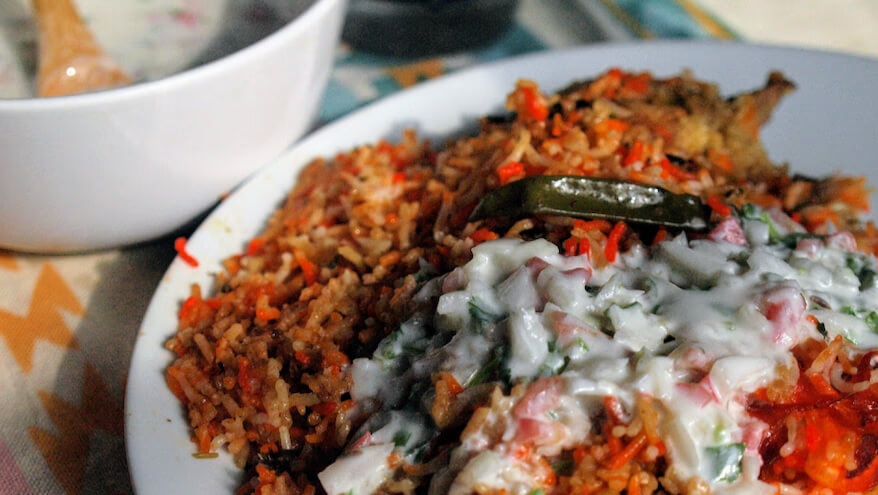どうも、お久しぶりです。夏といえば、カレー!カレーといえばの香取です!
と書き出したまま早数か月。
カレーはいつ食べたっておいしい。おせち料理に飽きたらカレーが食べたくなるのは私だけでしょうか。寒い冬だからこそご紹介させてください。
最近、雑誌やメディアでは「スパイスカレー」が良く取り上げられていたり、365日カレーを食べるカレーマニアも現れたりと、空前のカレーブームがきているとひそかに感じているのですが、私だって負けてはいられない(笑)
ほぼ毎日カレーを食べております。
モノサスの周年パーティーや忘年会では、パキスタン出身の夫が、本場のパキスタンカレー(インドカレー)をふるまったことが何度かあります。
そのたびに好評いただいているカレーのレシピを紹介してほしい!と依頼があったのですが、今回私が紹介したいのは知る人ぞ知る「ビリヤニ」です。
インドカレー好きな人は、ピンとくるかもしれません。
おいしいビリヤニを食べたら、ぜったいあなたも虜になるはず!
ビリヤニとは?
ビリヤニは、簡単に言えばインド周辺国で食べられている炊き込みご飯のようなもの。
スペインのパエリア、日本の松茸ご飯に並んで、インドのビリヤニは世界三大炊き込みご飯のひとつとも呼ばれているそうです。
お米(バスマティ米)、スパイス、お肉や野菜、豆、卵などを炒めて炊き込む料理です。
日本ビリヤニ協会によると、ルーツはペルシャ帝国(現在のイラン)。イスラム教の普及とともに南アジアに侵略した際にインドに入り、ムガル帝国時代に発展を遂げた食べ物だとされています。ですが、夫曰く、ビリヤニはパキスタンが本場という説もあります。
国や地域によって具材や作り方も違うようですが、インドはベジタリアン向けやチキンのビリヤニが多いことに比べ、パキスタンは豚肉以外のビーフ、マトン、チキンなどのお肉を使ったビリヤニが人気です。
ビリヤニとの出会い
そんなビリヤニと私の出会いは、さかのぼること7年前。
昔からインドカレー好きではありましたが、きっかけは夫でした。
まだ結婚前のこと。1ヶ月に渡るイスラム教のラマダンが明け、イードと呼ばれるお祝いの日に夫家族の家に招待してもらいました。
ドアを開けるとそこは異国の香り。まさにインドカレーレストランの匂いそのものでした。そしてキッチンには整頓されたたくさんのスパイスの入った瓶。
なんだかワクワク。
義母や妹たちが忙しそうにキッチンを行き来していました。義父の合図とともに、みんな集合。
テーブルの上には、カレー2種と魚のフライ、サラダ、そして大きなお皿に、初めて見る茶色いご飯がドーンと置かれていました。よくみるとお肉がゴロゴロ。横には白いソースが添えられています。心なしかみんなうれしそう。
どうやって食べるのか観察していたら、それぞれのプレートにご飯をよそい、白いソースをかける。そして器用に右手で食べ始めました。
これが、私とビリヤニとの出会いです。
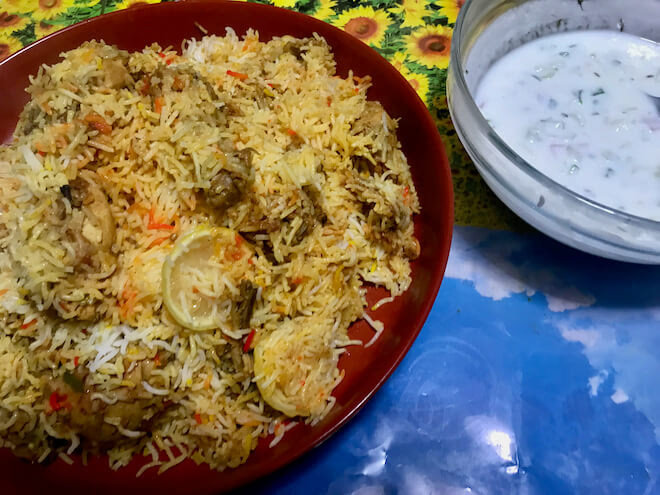
はじめてのビリヤニは、ビーフビリヤニ。
私も、みんなの真似をしてご飯の上に、白いソースを。手で食べることはできず、スプーンでいただきました。
細長い独特の香りがするカレー風味のお米。ビーフはやわらかく、カレーの味が染みていてすぐに好きな味だと感じました。
ソースの正体はヨーグルトで、その名も「ライタ」。
ごはんにヨーグルト!?食べたことのない組み合わせで、衝撃的でした。
ご存じない方は想像もつかないですよね。私の中ではカレー味のご飯と、ヨーグルトの組み合わせが最強なことに、すぐに気が付きました。
ライタもいろいろと種類がありますが、作り方は次にご紹介しますね。
そんなわけでパキスタン人の国民食ビリヤニは、出会ってすぐに私の好きなものランキングに浮上してきたのでした。

ピクニックにもビリヤニを持参しちゃうパキスタン人。
自分でも作れるようになりたいと、何度も夫や夫家族と一緒に作ってはいるのですが、
なかなか一人で仕上げる勇気がなく今に至っております。
今回も夫サポートのもと、メモを取りながらチキンビリヤニのレシピをまとめましたので、ぜひトライしてみてくださいね。
レッツクッキング!
使う材料はこちらです。我が家ではだいたいが目分量!のため、おおまかな分量ですが、恐れずに作ってみましょう。何か足りなければ、途中で足せば何とかなるはず。
<ビリヤニ> 5~6人前
バスマティ米 2カップ
鶏肉 1羽(約1kg)
トマト 1個
玉ねぎ 1/2個
青唐辛子 5本(辛さはお好みで)
コリアンダー 1~2株程度
塩 適量
油 ※想像より多め。結構思い切って使うのがポイント
おろし生姜、おろしにんにく 適量
レモン 1/2個
スパイス それぞれ適量
クローブ
カルダモン
ブラックペッパーホール
ターメリック
チリパウダー
クミン
コリアンダーシード
シナモンスティック
インディアンベイリーフ
ビリヤニマサラ ※マサラとは様々なスパイスをミックスした、インドカレーを作るときの強い味方です。ビリヤニ専用のマサラを使うと味に深みが出ますよ!
ヨーグルト 適量
色付けのための赤い粉 ※自宅にあったものを使いました。着色料のようです。日本ではあまり手に入らないのでなくてもOK
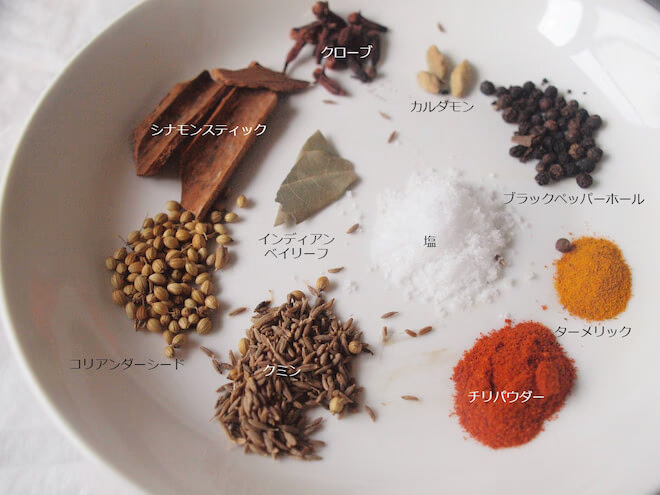
クミン 少々
ヨーグルト 1/2~1箱(300~400g程度)
玉ねぎ 1/2個
トマト 1/2個
コリアンダー お好みで
きゅうり 1/2本
塩 少々
我が家でかかる時間:約1時間半程度
1:バスマティ米を洗う
パキスタンではバスマティ米というお米をよく食べます。細長い、パラパラとしたお米で、ビリヤニにはかかせません。(同じインディカ米のタイ米では同じ風味は出せません)
水でさらっと洗って、30分ほど水につけておきます。

2:素材をカットする
トマト1/2個、玉ねぎ1/2個、そして鶏肉をカットしていきます。丸鶏のカットは、私には一苦労なので、我が家では夫にお願いしています。
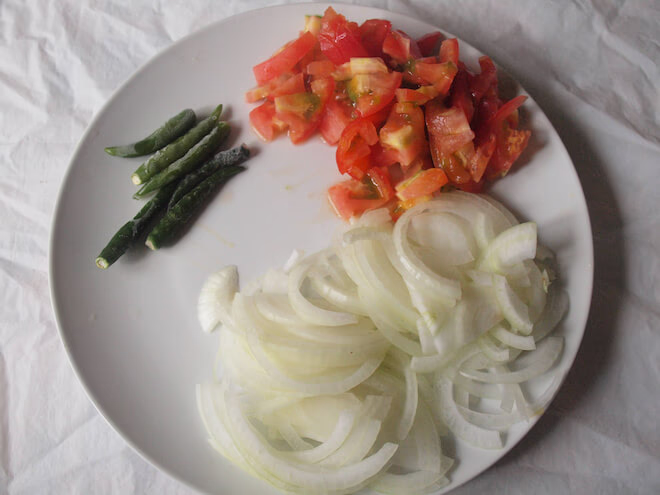
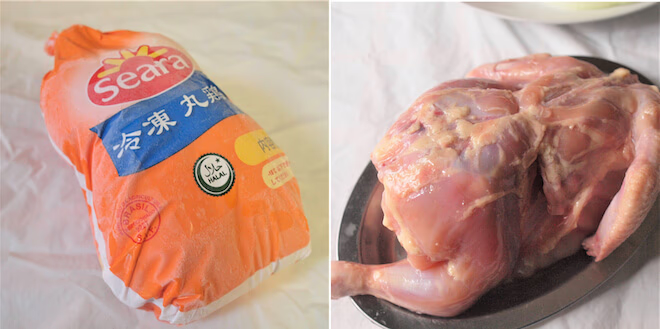
我が家でビリヤニをつくるときには、必ず骨付きの丸鶏を使います。 ビーフやマトンビリヤニを作るときも骨付きがベター。骨からダシがでるので、断然おいしいです。
3:スパイスを炒める
パキスタン料理は、油をたっぷり使うのがポイントです。ためらわずにたっぷりの油を注いでを温めたら、ホールスパイス(カルダモン・黒胡椒・クミン・コリアンダーシード、インディアンベイリーフ)を投入します。
ちなみに我が家で使っているのは「ハンディー」という日本で手に入れることが困難な土鍋ですが、家庭にあるカレーを作る鍋で大丈夫です。
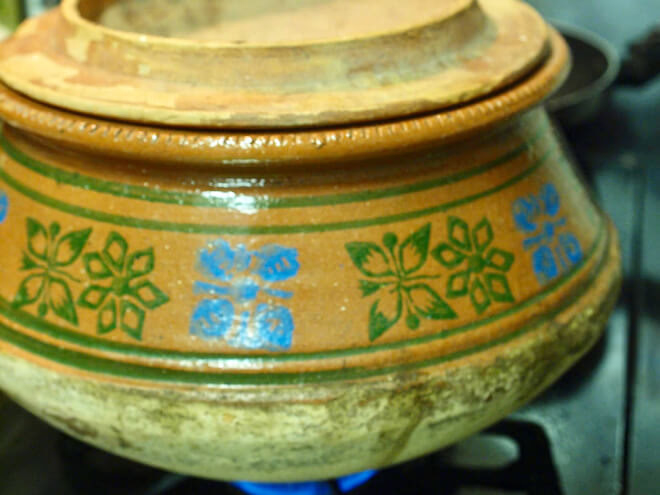
口が少し狭くなったこんな感じの土鍋で、夫がパキスタンの実家で使っていたものを持って帰ってきて以来、我が家でカレーをつくるときにはこれを使っています。煮込み料理は土鍋でつくると、火の通りが早く、お肉や豆が柔らかく仕上がっておいしいです。
4:玉ねぎを投入。フライドオニオンを作ります。
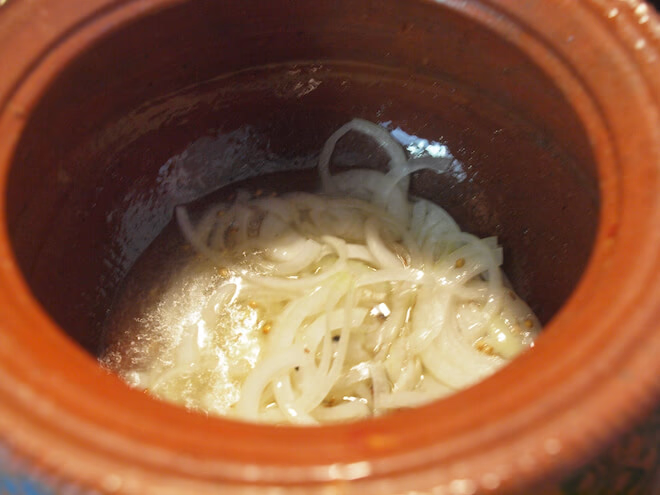
中火で焦がさないようにじっくり玉ねぎを炒め、塩、チリパウダー、ターメリックを加えて炒め続けます。
油となじんできたら、おろし生姜とおろしにんにくを加えます。茶色くなるまで炒めたら、玉ねぎをひとつまみだけ取り出しましょう。こちらはのちほど使います。

5:トマトを投入
乱切りしたトマトを加えます。形がわからなくなるくらいに炒めましょう。
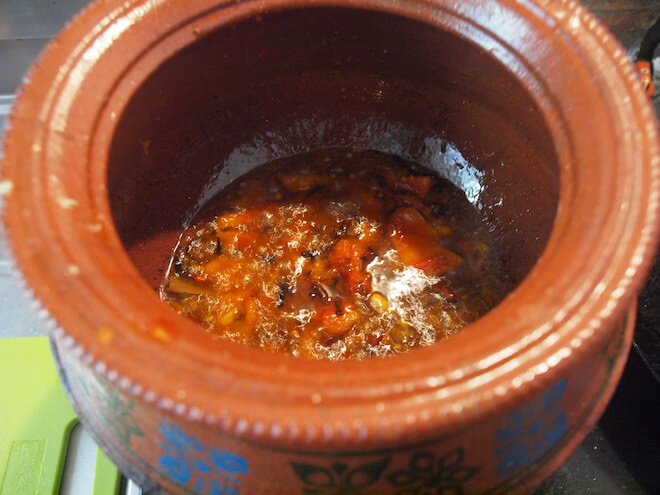
6:チキン投入
ここでいよいよチキンの出番です。カットした骨付きチキンを鍋に入れ、スパイスなどが馴染むまで、焦がさないようにじっくり炒めていきます。
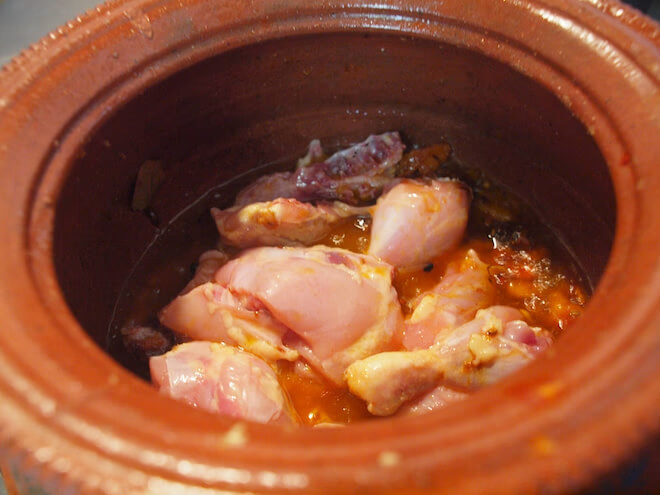
7:マサラで味を調整
最低限のスパイスと塩、ミックススパイスで味を整えるのが、パキスタンの家庭の味。味見をしながら、塩で調整します。今回は、このマサラを使いました。以前ご紹介したイスラム横丁に行けば色々な種類のマサラを手にすることができますが、ネットでも買えますので探してみて下さいね。
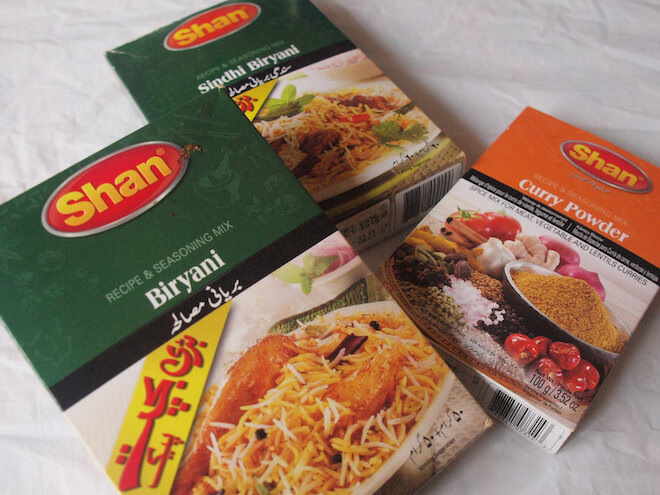
パキスタン国内でも大きく分けて3つの種類があります。ポピュラーなのがシンディービリヤニで、他にもボンベイビリヤニ、ハイデラバードビリヤニなど地域によって違いがあるようです。今回はシンディビリヤニマサラを使いました。
8:ヨーグルトを入れて煮詰める
カレーの仕上げにヨーグルトと刻んだコリアンダーをお鍋のなかに。軽くかき混ぜて、肉が柔らかくなるまで中火で炒めていきます。
これでチキンカレーの出来上がり。このまま食べてもおいしいですが、ビリヤニ完成までもう少しお預けです。
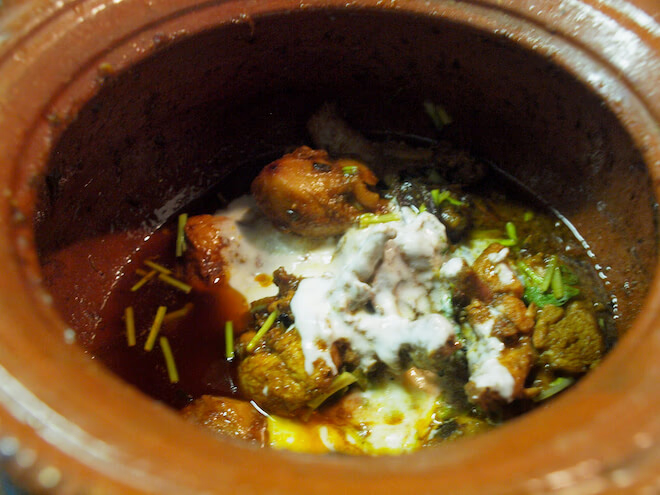
9:お米を茹でる
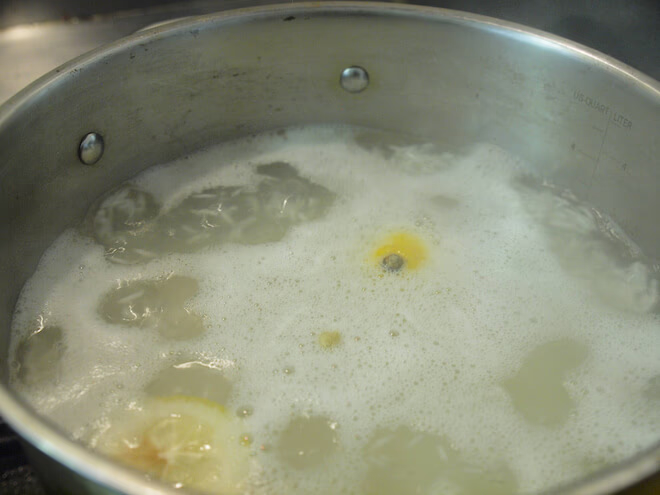
バスマティ米は、炊くのではなく茹でます。日本のお米を炊くよりもたっぷりの水を使って、少量の油を加え、グツグツと7~8分くらい半茹でします。香りつけにレモンとカルダモンも一緒に茹でるのがパキスタン風。お米を指でつぶしてみて、少し固めな状態でOKです。ザルに移して、きっちり水切りをしましょう。
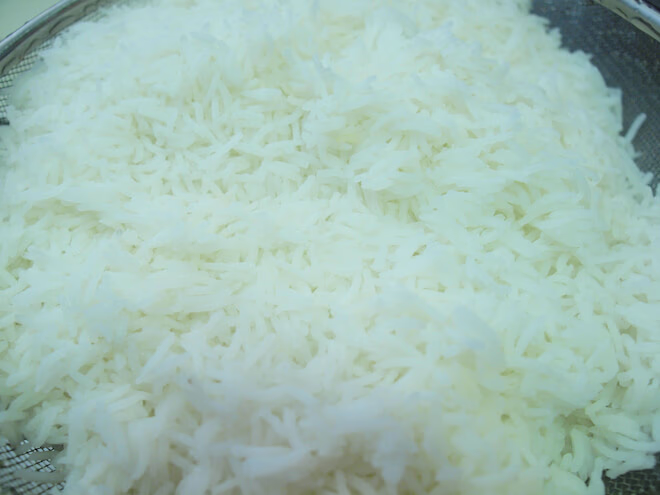
独特のいい香り~
10:カレーとライスを交互に重ね合わせて蒸す
ここからがビリヤニのメインイベント。大きめな別のお鍋を用意します。
トマト、コリアンダー、レモンもカットしておきましょう。
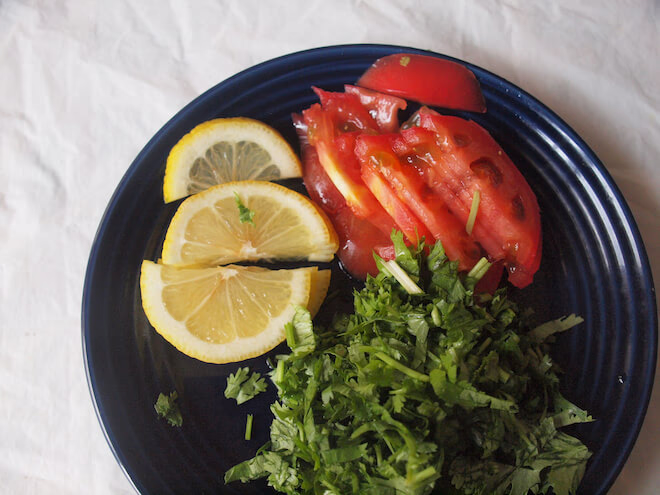
まずはさきほど作ったチキンカレーを敷き詰め、その上に半茹でしたバスマティライスで入れてならします。カットしておいたコリアンダーとスライスした生トマト、グリーンチリ、そして最初にとっておいたフライドオニオンをふりかけるようにのせていきます。
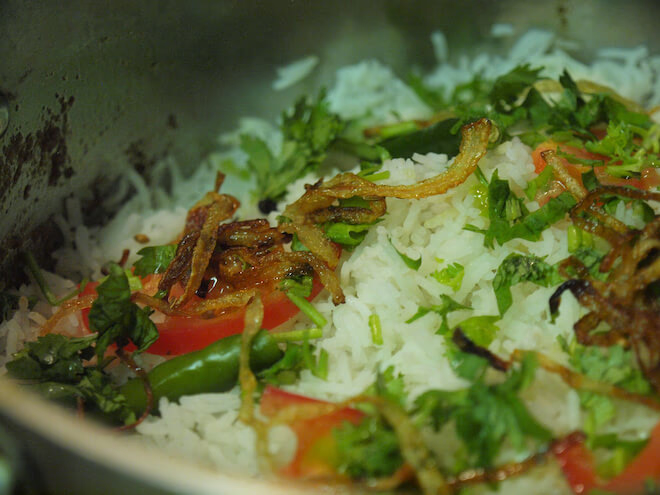
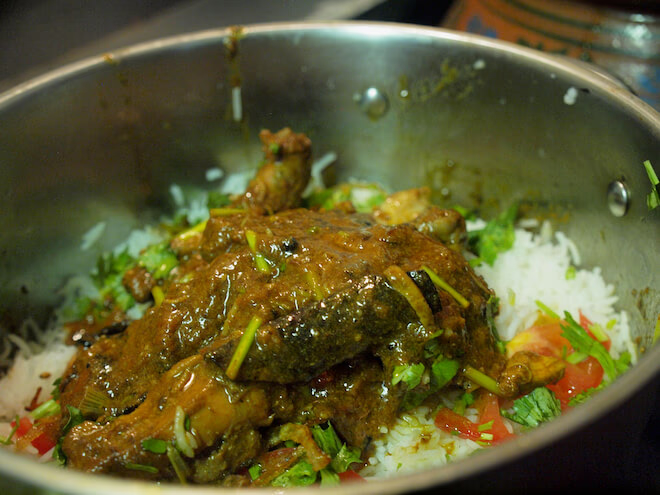
その上に、またチキンカレーを敷き詰めます。
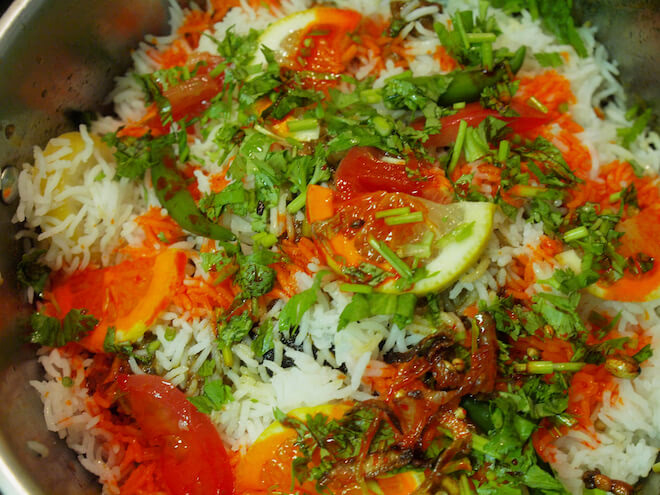
ライスとカレーの層を2段つくったら、仕上げにもう一度パクチーやトマトをふりかけ、最後にレモン、そして色付けの赤い着色料をいちばん上に添えます。
私はビリヤニのこの工程にアートを感じています。なぜ、わざわざこのように何層かにするのか?
深い意味があるのかと思いきや、夫に尋ねると「こうすると最後に混ぜやすく、カレーがご飯にしみるから」だそうです。
11:密閉して蒸す
あとはひたすら、ライスとカレーを火にかけ、蒸していきます。
ここでのポイントは、蓋が開かないようにしっかり密閉させること。
敷き詰めたライスの上に新聞紙やキッチンペーパーを置き、蓋も新聞紙でくるんだあと、上から重しをしています。
我が家ではこんなふうに、鍋を重しに使い30分くらい弱火で蒸していきます。焦げるのがちょっと怖いけれど、焦らずできあがるのを待ちましょう。
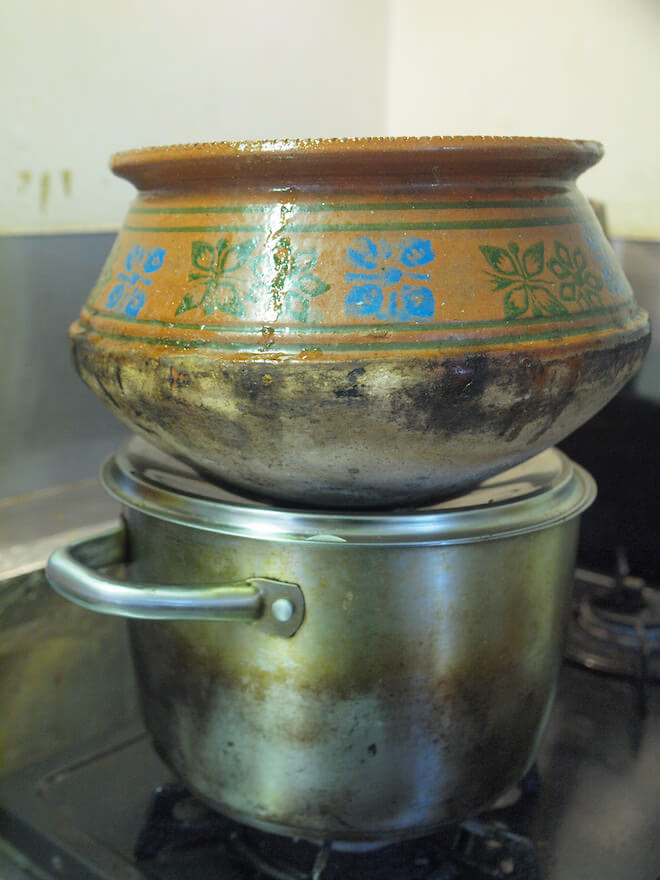
12:仕上げのソースづくり
ビリヤニができあがるまでのあいだ、ライタというヨーグルトソースをつくります。材料を刻み、お好みの味に仕上がるように混ぜていきます。
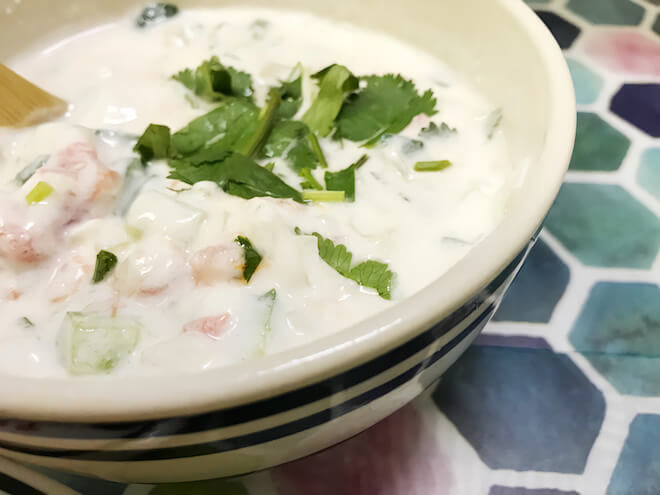
いただきます!
30分程度焚き上げ蒸したら、いよいよできあがり。鍋から食欲をそそる香りがダダもれです。
蓋を開け、きれいな層に、やさしく垂直にしゃもじをいれて書き混ぜ、お皿に盛り付けます。
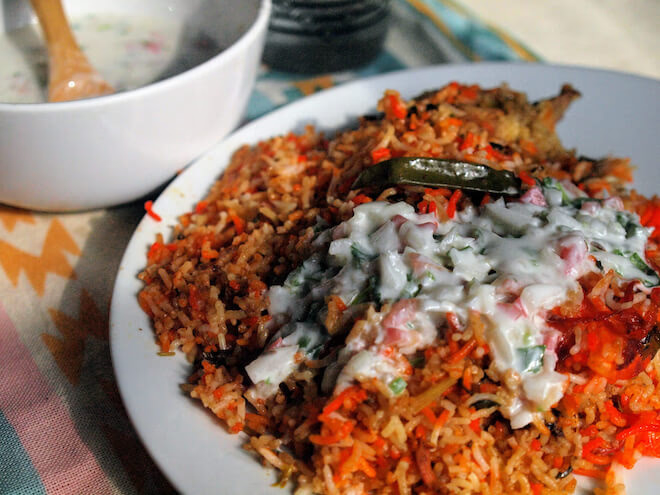
間違いない!夫が作るビリヤニは、最高においしいです。
日本人が作る炊き込みご飯に比べると作る工程も複雑ですが、1時間以上かけて作る甲斐がありますよ。
ビリヤニと見た目も似ている米料理に「プラオ」があります。こちらは生の米とカレーを混ぜ合わせて作る手法で、炊飯器でもできるので初心者向けかもしれません。
私も、プラオなら一人で作ることができます。
家庭で食べるビリヤニは大皿から取り分けて食べるので、何度もお代わりをしてしまいます。
飲むように食べられるので、自分がどれだけの分量を食べたのかわからないほど…恐ろしい食べ物です(笑)
インドカレーといえば、カレーをナンで食べるのが代表的ですが、レストランでもビリヤニを食べられるところがあります。(ただ当たりはずれもあるのでご注意を…)ぜひ挑戦してみてください!
「カレーとライスを交互に重ね合わせて蒸す」の行程から仕上げるところまでは、動画にも収めています。ちょっとわかりにくかった…という方は、よろしければご覧ください!彩りきれいに層にしていくアートな部分もしっかり抑えてあります。
